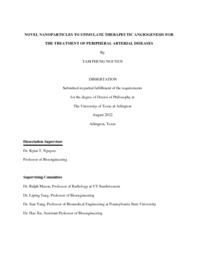
ATTENTION: The works hosted here are being migrated to a new repository that will consolidate resources, improve discoverability, and better show UTA's research impact on the global community. We will update authors as the migration progresses. Please see MavMatrix for more information.
Show simple item record
| dc.contributor.advisor | Nguyen, Kytai | |
| dc.creator | Nguyen, Tam Phung | |
| dc.date.accessioned | 2023-06-30T16:31:40Z | |
| dc.date.available | 2023-06-30T16:31:40Z | |
| dc.date.created | 2022-08 | |
| dc.date.issued | 2022-08-15 | |
| dc.date.submitted | August 2022 | |
| dc.identifier.uri | http://hdl.handle.net/10106/31454 | |
| dc.description.abstract | Peripheral arterial disease (PAD) is a severe impairment of arterial vessels resulting in obstruction of normal blood flow in the legs, leading to acute or chronic lower limb ischemia and subsequently high morbidity and mortality rates. Common treatments for PAD, such as medications and surgical revascularization, have several limitations. For instance, medications used to lower cholesterol, reduce high blood pressure, control blood sugar, prevent blood clots, and reduce/delay symptoms such as leg pains. Still, they cannot treat the established disease directly and often cause side-effects, including bleeding, headache, and diarrhea. Meanwhile, many elderly PAD patients cannot undergo surgical options. Therefore, it is important to develop an alternative therapy to treat PAD.
The long-term goal for this thesis research is to develop novel biodegradable dual-modal imaging nanoparticles (DINPs) to precisely deliver therapeutic reagents that provide cell protection and facilitate the formation of blood vessels de novo at ischemic sites while allowing detection of the NP location and monitoring of their therapeutic effectiveness for PAD treatment. The results demonstrated that DINPs were fabricated successfully with a homogenous size range around 150-200 nm. These DINPs had intrinsic imaging properties including fluorescent intensities in DAPI, FITC, and Cy5 channels as well as consisted of photoacoustic (PA) images at the deep tissue (about 11 mm in ex vivo). In vitro imaging, DINPs were used for tracking the particle cellular uptake by endothelial cells via their intrinsic fluorescent properties. DINPs were also visualized in gastrocnemius muscle via MSOT imaging system. EpoR plasmids released from EpoR DINPs demonstrated their properties in protecting cell damaged from stress conditions and facilitating tube formation in vitro studies. In addition, EpoR DINPs enhanced angiogenesis to prevent ischemic legs from amputation and improved physical capability in PAD mice.
In conclusion, our novel biodegradable DINPs are photostable, biodegradable, and able to encapsulate therapeutic EpoR plasmids in addition to showing intrinsic imaging properties including fluorescence and photoacoustic images to allow in vivo NP tracking/detection, thereby conferring distinct advantages over to current imaging approaches. The EpoR DINPs not only could enhance the growth of blood vessels but also could be used for detection in deep muscle tissues during the treatment for adjusting the effective doses. This thesis research impact is significant in the bioengineering and health science fields as it is a paradigm shift to facilitate nanotechnology in the treatment of PAD | |
| dc.format.mimetype | application/pdf | |
| dc.language.iso | en_US | |
| dc.subject | Angiogenesis | |
| dc.subject | Peripheral arterial diseases | |
| dc.subject | PAD | |
| dc.subject | EpoR | |
| dc.subject | EPCs | |
| dc.subject | Imaging guided treatment | |
| dc.subject | BPLPAT | |
| dc.subject | DINPs | |
| dc.subject | Dual modality imaging | |
| dc.subject | Photoacoustic imaging | |
| dc.subject | MSOT | |
| dc.title | NOVEL NANOPARTICLES TO STIMULATE THERAPEUTIC ANGIOGENESIS FOR THE TREATMENT OF PERIPHERAL ARTERIAL DISEASES | |
| dc.type | Thesis | |
| dc.date.updated | 2023-06-30T16:31:40Z | |
| thesis.degree.department | Bioengineering | |
| thesis.degree.grantor | The University of Texas at Arlington | |
| thesis.degree.level | Doctoral | |
| thesis.degree.name | Doctor of Philosophy in Biomedical Engineering | |
| dc.type.material | text | |
| dc.creator.orcid | 0000-0002-8338-7436 | |
Files in this item
- Name:
- NGUYEN-DISSERTATION-2022.pdf
- Size:
- 4.569Mb
- Format:
- PDF
This item appears in the following Collection(s)
Show simple item record


